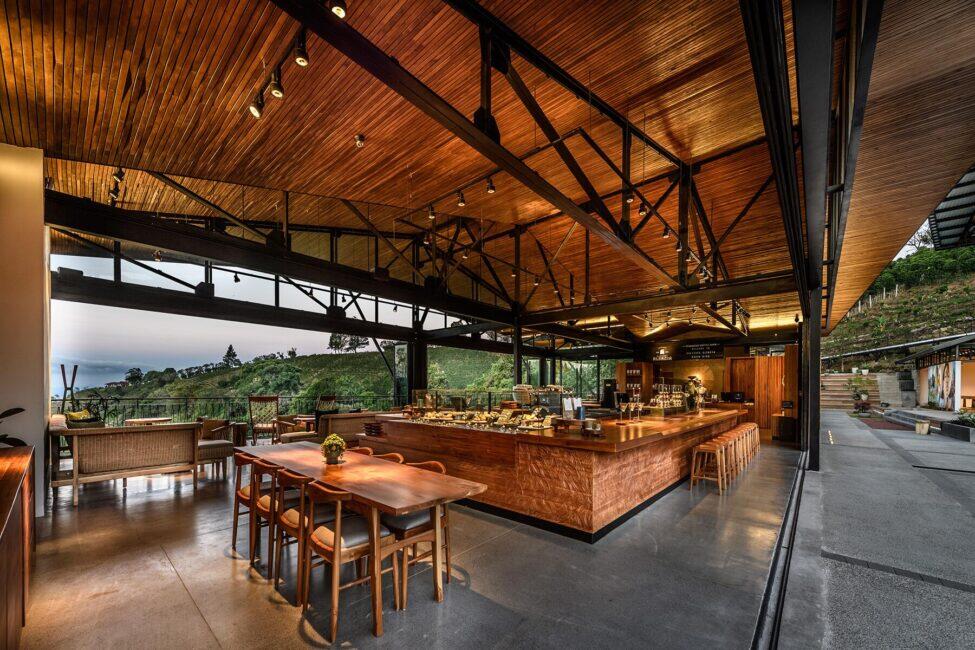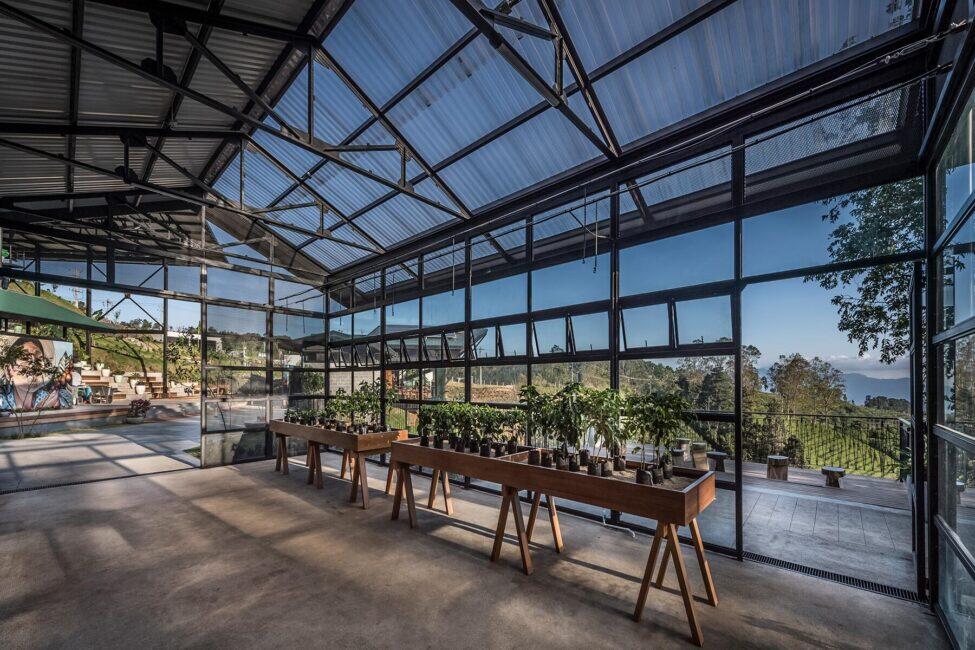I was staring into the smoking crater of a volcano, wearing a hard hat (just in case), and thinking to myself, ‘I really could use another cup of coffee.’
Coffee, it seems, is everywhere in Costa Rica, but it’s not one of the top coffee-producing countries—not by a long shot. But there is an immense coffee culture here. At the Costa Rica Marriott Hacienda Belem, we were shown how Costa Ricans traditionally make coffee—a kind of pour-over system that resembles a coffee-stained sock rigged up in a wooden contraption (that produces delicious coffee).
After our first cup, we began ascending the mountain in a van. We found ourselves in fields dominated by two crops: strawberries and coffee. Billboards advertise both, and various roadside restaurants, trucks, and stands are dedicated to either (strawberries seemed to have a slight edge over coffee). Although I had a big breakfast at the hotel (I got kind of shipwrecked on this machine that squeezes whole oranges into juice), I was ready for some strawberries and some coffee by the time we reached the visitor’s center at the volcano.

It smelled strongly of sulfur, and we were given color-coded hard hats. These were ostensibly just in case the mountain started shooting projectiles (which is unlikely, as they have good instruments to detect these things nowadays) but more practically to make sure nobody spent more than their allotted 20 minutes at the viewpoint. Once your group leaves, you stick out among the next group, whose hats are a different color.
Recommended Fodor’s Video
The hats are also for head counts (they count how many they give out and get back, so if you’re not back, it’s assumed you’re still on the crater or stole the hat), as apparently the air can become so toxic at the viewpoint that it becomes dangerous, and you have to hide in this little concrete shelter near the viewpoint railing when a light on the roof starts to flash. Sulfur aside, I was more affected by the 8,800-foot elevation at the caldera, and the short uphill walk through the eggy-smelling air seemed to have zapped a day’s worth of energy from me. Time for coffee.
Before we started up the mountain, our guide told us about “a visit to a coffee plantation,” but when we got there, we found it was a Starbucks coffee plantation, and there was a Starbucks inside.

Now, I loved the sock coffee at the hotel, but the prospect of an iced Americano sent me to the moon. We were booked for a tour of the plantation, but not for another hour, so we breezed past the very fancy green wall adorned with the famous Starbucks logo and found ourselves in a legit Starbucks store, complete with pastries, espresso, and coffee grown right in the surrounding fields. The best part? The coffee shop had commanding views of the coffee fields, the valley snaking down the side of the volcano, and a waterfall cascading torrents of fresh rainwater.
It’s not normal to find a coffee shop in the middle of a coffee field, right? Right. Starbucks didn’t actually own any coffee farms prior to this, and Hacienda Alsacia is the only one that the company owns outright. Starbucks normally sources its coffee from local farm owners in the countries it buys coffee from, but it acquired Hacienda Alsacia in 2013 to operate as a research and development farm.
When we began the tour (after more iced Americanos than I’d care to admit), we learned more. Starbucks has exhaustive criteria for its coffee suppliers, but the R&D farm here is so Starbucks can attempt to address some of the challenges faced by their suppliers: climate change, coffee rust, and resource availability.

As we were given the layperson’s overview of how coffee grows, why it grows where it grows (it likes sunny, well-watered higher elevations in the tropics), and how it’s roasted, we also learned about what kind of research takes place at Hacienda Alsacia. Starbucks has performed research on climate change and disease-resistant coffee plants and also looked at production methods that use less energy and water (the entire farm is solar-powered). Starbucks also uses the farm for the immersion of its store employees so they can see its product at the source and for training its farmers in the region on sustainability and ethical sourcing.
During the tour, we walked through the coffee fields, seeing the small green berries on the trees that weren’t yet ripe (they’re harvested during the winter, so it was pretty quiet during our mid-summer visit). The berries are processed into the green coffee beans, which are dried and then roasted. We were shown the baskets the pickers wear around their waists (yes, much of the world’s coffee is still hand-picked), learned about how they’re paid (per basket), and saw the machine used to sort and process the “cherries.” They’re washed in fresh water, to remove any dirt and small stones, and then the pulps are removed by a grinder. Then it’s on to drying racks, and the roaster, where the coffee gets that distinctive flavor (it only takes a couple minutes).

Finally, it was on to the tasting room—open air with a view of the waterfall—while our guide went over the tasting notes for the Hacienda Alsacia roast, which is only available at their on-site store—and sometimes at Starbucks Reserve pop-ups in the United States. Because the goal of the farm is really R&D, it doesn’t produce enough product for large-scale export, which is why you have to visit the place to try it (in my unqualified opinion, I’d say it’s worth it, but I’m also easily taken in by a waterfall).
Was the tour kind of an hour-long ad for Starbucks? A little bit, sure. But if you’re genuinely curious about coffee, the experience makes for a pretty good “Guess What I Did in Costa Rica?” conversation starter.
INSIDER TIPThere are two experiences—the tour and the coffee experience—and they can book up during the peak tourist season, so it’s worth booking ahead.
Not too long after the tasting, our guide coaxed us away from the gift shop as I resisted the urge to order one more iced Americano for the road. We had a date with some strawberry smoothies at a popular restaurant up the road (if the caffeine didn’t get me, the fructose would).
Back at Hacienda Belen the next morning, sipping my sock coffee from my lovely Juliet balcony (my suite had two of them), with hummingbirds and early morning rainfall for company, I thought, it’s good coffee, but there’s just something missing. It’s the waterfall, I decided. Coffee just tastes better with a waterfall.





